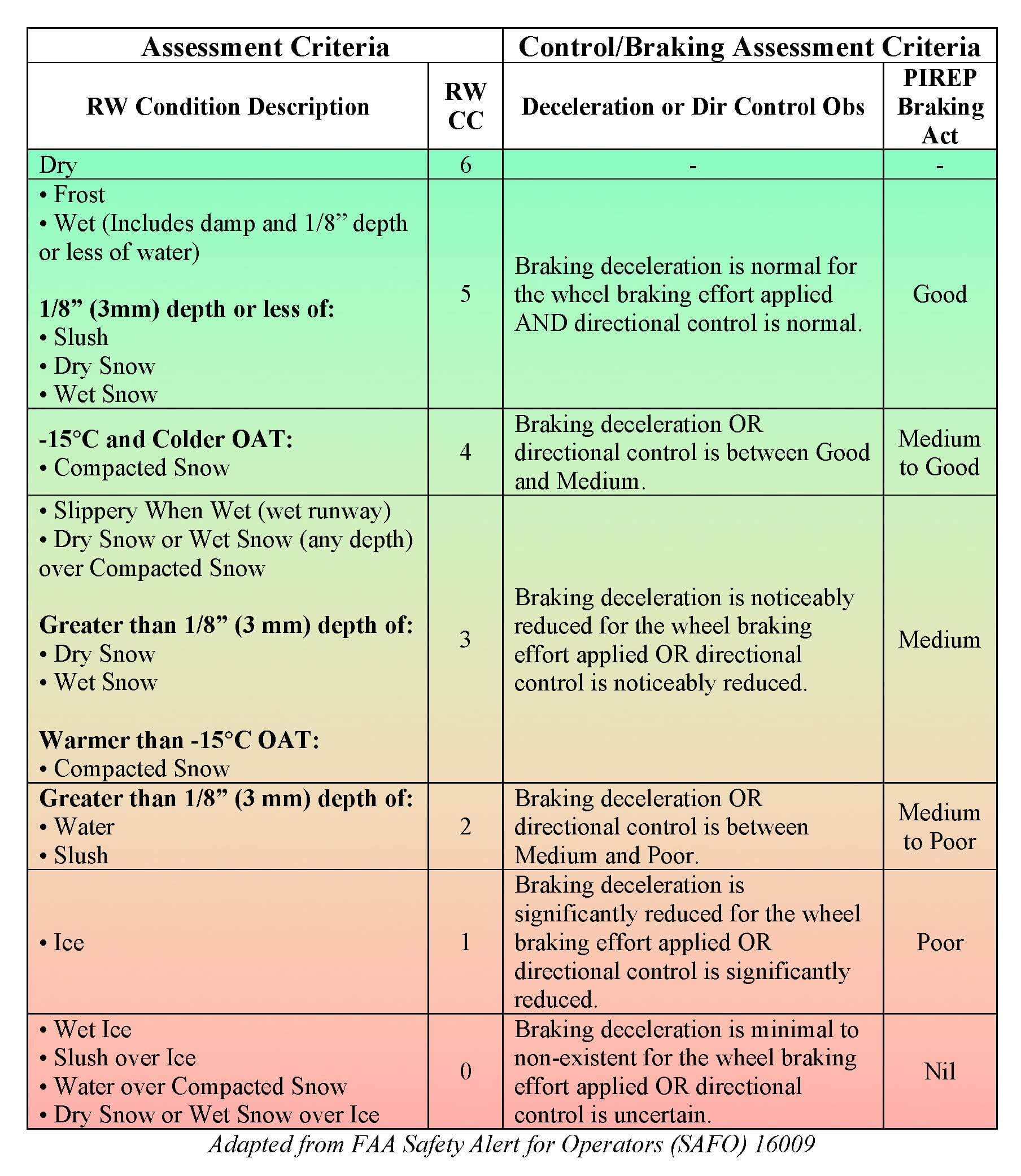The threats from winter weather are not limited to flight, but also produce potentially hazardous conditions for push-back, taxi, takeoff and landing. Improper ground handling of an aircraft in icing conditions and non-adherence to SOPs could result in catastrophic accidents, such as the infamous Air Florida Flight 90 mishap. Other contaminated airport mishaps include runway overruns, skidding off the runway while attempting to turn onto a taxiway or sliding off a taxiway. In order to help pilots assess runway contamination and breaking action, the FAA issued a Safety Alert for Operators (SAFO) on Runway Assessment and Condition Reporting. In this SAFO, the FAA utilized a Runway Condition Assessment Matrix (RCAM) to assess runway conditions and reports. Unless the breaking action is excellent, i.e., 6, breaking-action reports are supplied to the pilots in the form of NOTAMs and broadcast on the ATIS frequency.

Clearing contaminants: During the winter season, snow, slush, ice, and water accumulate on ramps, taxiways and runways. Unlike roads and highways that use heavy-duty steel plows and melting salts that often corrode metals, airport operations exercise caution to protect the runway surface and mitigate the corrosion of aircraft surfaces. Airport operations use polyurethane tipped snowplow blades, brush rollers, blowers, and relatively expensive chemicals to keep runways clear of contaminants. Sand is also applied on runway surfaces to increase traction.
Acceleration and Takeoff Problems: There are significant negative consequences attributable to a contaminated runway. During takeoff for instance, thrust that would otherwise accelerate the aircraft to rotation speed is diverted towards compaction and displacement of snow, slush, and water. The dislodging of runway contaminants by the aircraft tiers may also impinge on the aircraft surface, potentially spoiling the airflow, damaging the airframe, or interfering with the flight controls. The ingestion of these runway contaminants may effectively act like foreign object debris (FOD) when sprayed into the engines and result in structural damage and loss of engine performance (reduced thrust). Runway contamination therefore reduces aircraft acceleration and increases the takeoff distance.
Deceleration: During landing or in an aborted takeoff, runway contaminants reduce the friction between the tires and runway. Therefore, aerodynamic breaking rather than wheel breaking is more effective while operating on contaminated surfaces. On a related concern, large ice particles could deposit on and/or dislodge from the wheels, engines, landing gear, and airframe resulting in damage.
Taxiing is a critical phase of flight: On 11 November 2019, American Eagle flight 4125 slid off the runway while trying to clear the runway onto a taxiway in icy conditions at Chicago O' Hare International Airport. Fortunately, there were no injuries to passengers or crew members. While operating on contaminated runway surfaces, taxiing at slower speeds will significantly help with directional control. It may be safer to exit the runway at a subsequent taxiway intersection rather than making a high-speed turn and applying excessive wheel breaking to access a nearer taxiway.

References and Useful Resources
[1] AC No: 150/5200-30D Airport Field Condition Assessments and Winter Operations Safety.
[2] Bell L (2005) Cold Facts: Braking Action Reports. AOPA Safety Brief SB03-3/05.
[3] FAA (2015) SAFO 16009: Runway Assessment and Condition Reporting.
[4] Golson J (2015) It Takes Crazy Effort to Clear Snow from Airport Runways.






















































































































